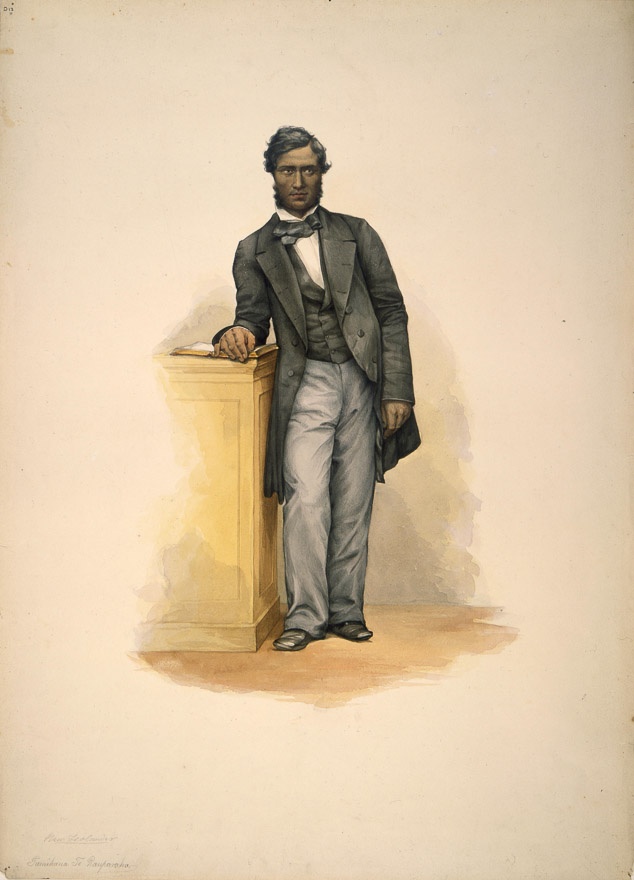
In this painting by George Angus, Tamihana Te Rauparaha, in London in 1852, is shown in a formal English suit.
Tamihana Te Rauparaha, also known as Katu, was the son of the great Ngati Toa leader Te Rauparaha and his fifth and senior wife, Te Akau of Tuhourangi. He was born at Pukearuhe, a Ngati Tama pa in northern Taranaki, during the Ngati Toa migration from Kawhia to the south. He took the name Tamihana (Thompson) when he was baptised by Church Missionary Society missionary Octavius Hadfield in March 1841. He was known from that time on as Tamihana.
As a child Katu accompanied his father on war expeditions, including the storming of the Ngai Tahu pa at Kaiapoi in 1831. His subsequent written accounts of these and other Ngati Toa campaigns have been used extensively by historians.
In November 1839 he and his cousin Matene Te Whiwhi travelled to the Bay of Islands to seek a missionary for the Kapiti area. As a result Octavius Hadfield moved to the Kapiti coast. In 1843 Tamihana and Te Whiwhi went to the South Island and preached Christianity to their relations there and to Ngai Tahu, their former enemies.
He attended St John's College in Auckland and was there in 1846 when his father was arrested on the orders of Governor George Grey. He visited his father, who urged him to go to Otaki and prevent Ngati Raukawa taking any retaliatory action. He did so, and Ngati Raukawa were dissuaded from joining Te Rangihaeata's plans to attack Wellington. During Te Rauparaha's detention in Auckland, Tamihana and other Ngati Toa leaders agreed to sell the Wairau plains to the government for £3000.
As demonstrated in this painting, Tamihana adopted the clothing and lifestyle of an English gentleman. He lived in a European-style house and had European servants. He became a successful sheep farmer and a man of considerable wealth.
In December 1850 Tamihana left for England, and in June 1852 he was presented to Queen Victoria. Later in the same year he returned to New Zealand. Along with others, he now sought to establish a monarchy for the Maori people, to give them a unity beyond that of the tribe and to bring law and security to their land. Potatau Te Wherowhero of Ngati Mahuta eventually agreed to become king and was installed at Ngaruawahia in 1858. Tamihana supported the King movement's attempt to halt the sale of Maori land. He wanted to limit further European encroachment so that the two races could live peacefully side by side.
These hopes appeared dashed when fighting erupted in Taranaki in 1860. He broke with the movement, and in May 1860 he opposed the raising of the King's flag at Otaki. He went to Papawai to oppose the King's influence in Wairarapa. In the later 1860s Tamihana and Te Whiwhi used their influence to prevent the wars from reaching the Wellington area.
By 1864 Tamihana held the position of senior assessor and received an annual salary of £100. In 1866 he supported the sale of the Rangitikei–Manawatu block to the government for £25,000.
Tamihana Te Rauparaha died on 22 or 23 October 1876.

Community contributions